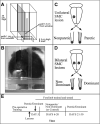The "good" limb makes the "bad" limb worse: experience-dependent interhemispheric disruption of functional outcome after cortical infarcts in rats
- PMID: 20141287
- PMCID: PMC4888870
- DOI: 10.1037/a0018457
The "good" limb makes the "bad" limb worse: experience-dependent interhemispheric disruption of functional outcome after cortical infarcts in rats
Abstract
Following stroke-like lesions to the sensorimotor cortex in rats, experience with the ipsi-to-lesion (ipsilesional), "nonparetic", forelimb worsens deficits in the contralesional, "paretic", forelimb. We tested whether the maladaptive effects of experience with the nonparetic limb are mediated through callosal connections and the contralesional sensorimotor cortex. Adult male rats with proficiency in skilled reaching with their dominant (for reaching) forelimb received ischemic bilateral sensorimotor cortex lesions, or unilateral lesions, with or without callosal transections. After assessing dominant forelimb function (the paretic forelimb in rats with unilateral lesions), animals were trained with their nonparetic/nondominant forelimb or underwent control procedures for 15 days. Animals were then tested with their paretic/dominant forelimb. In animals with unilateral lesions only, nonparetic forelimb training worsened subsequent performance with the paretic forelimb, as found previously. This effect was not found in animals with both callosal transections and unilateral lesions. After bilateral lesions, training the nondominant limb did not worsen function of the dominant limb compared with controls. Thus, the maladaptive effects of training the nonparetic limb on paretic forelimb function depend upon the contralesional cortex and transcallosal projections. This suggests that this experience-dependent disruption of functional recovery is mediated through interhemispheric connections of the sensorimotor cortex.
(c) 2009 APA, all rights reserved.
Figures




References
-
- Adkins DL, Voorhies AC, Jones TA. Behavioral and neuroplastic effects of focal endothelin-1 induced sensorimotor cortex lesions. Neuroscience. 2004;128:473–486. - PubMed
-
- Adkins-Muir DL, Jones TA. Cortical electrical stimulation combined with rehabilitative training: enhanced functional recovery and dendritic plasticity following focal cortical ischemia in rats. Neurology Research. 2003;25:780–787. - PubMed
-
- Allred RP, Jones TA. Unilateral ischemic sensorimotor cortical damage in female rats: forelimb behavioral effects and dendritic structural plasticity in the contralateral homotopic cortex. Experimental Neurology. 2004;190:433–445. - PubMed
-
- Allred RP, Maldonado MA, Hsu JE, Jones TA. Training the “less- affected” forelimb after unilateral cortical infarcts interferes with functional recovery of the impaired forelimb in rats. Restorative Neurology and Neuroscience. 2005;23(5-6):297–302. - PubMed
Publication types
MeSH terms
Grants and funding
LinkOut - more resources
Full Text Sources
Research Materials

